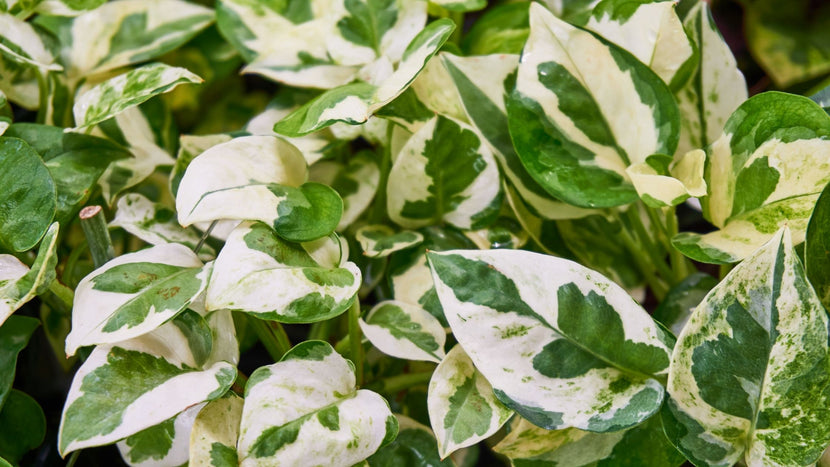Growing Pothos Plants
Plant Guide

Pothos is one of the easiest plants to care for. Beginners will love it since it's well-known to be an easy way to get started. New houseplant growers get excited as pothos plants begin to stretch out and run like sprinters. Each runner can stretch out to 6 to 10 feet if happy. They come in a variety of foliage colors from gold, to neon green, to silver and green variegated, as in the Silvery Ann Pothos.
Pothos can be allowed to hang down from a mantle or bookshelf, or as many growers like to do, they can be supported and grown along walls or the tops of kitchen cabinets.
Pothos plants make great plants to grow in your bathroom, kitchen, or office because they are very tolerant of low light conditions. Pothos likes a wide variety of light conditions, but they do not do well in direct sunlight, so avoid south-facing windows when possible.
When grown indoors as a houseplant, pothos can grow between 1 to 2 feet per year. Under ideal conditions, the leaves are four to six inches apart on the stems. If you notice that the leaves are spaced out further than 6 inches, it’s a sign that the plant is not getting enough light and is stretching.
Ground Rules
Light
Under the dense canopy of the jungle regions of the world, Pothos has evolved to thrive in low light. The larger leaves of the mature plant allow it to collect the most sunlight. The mature leaves can grow quite large in the wild, up to 3 feet. As houseplants, they typically remain juvenile, and the leaves will generally reach 8 inches long.
Low light levels are best for pothos plants, and finding the perfect balance is essential for the plants to maintain the best coloration. The simple rule of thumb is, the more variegation the plant has, the more light it requires to stay colorful. For example, a Jade Pothos can tolerate lower light than a Marble Queen Pothos.
Water
Pothos plants grown in soil don’t mind drying out between watering. Poke your finger into the soil, and if it feels dry, the plant can probably use water. Do not allow soil-grown pothos to sit in a dish for extended periods, as this often causes the roots to rot. Generally, a pothos plant will require water once per week in warmer months and no more than every two to three weeks in the fall and winter.
Soil
Growing naturally in the nutrient-rich, loamy soils of the rainforests, any “fluffy” soil will work for pothos. Soils that contain peat moss, perlite, and vermiculite are most commonly sold in garden centers. If the bag feels light when you pick it up, the soil is perfect for pothos plants.
Food
As a reasonably fast-growing plant, pothos plants require regular fertilization, especially in the spring and summer, which is their typical growing season.
Most growers add a liquid fertilizer at half-strength to their water every other time they water. You can also use a granular fertilizer sprinkled on the soil surface at the recommended rate. The perfect amount of nutrients will be released to the plant's root zone each time you water.
Pothos grown in water benefit from a small amount of fertilizer added to the water once a month. This brings up a good point; when growing plants in water, be sure to change the water occasionally so that it does not become stagnant, which can be harmful to the roots.
How do you grow Pothos Plants in Water?
How to Propagate Pothos
Do I need to prune Pothos Plants?
Types of Pothos Plants
| Image: | Name: |
Foliage Color: |
|---|---|---|
 |
Neon Pothos | Yellow-Green |
 |
Jade Pothos | Solid Green |
 |
Marble Queen | Cream and Green Variegated |
 |
Golden Pothos | Gold and Green Variegated |
 |
Pearls and Jade | White and Green Variegation |
 |
Satin Pothos | Green with Silver Variegation |

